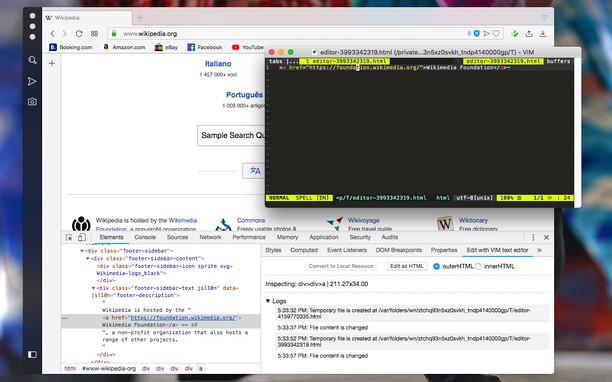

That graphical environment might be your Linux desktop, a Mac, or even a Window system. For example, if you're a Linux admin and you work with Vim all day on all of your servers, you might want to leverage that knowledge even when you're working in a graphical desktop environment. With that said, there are a couple of good reasons to use a graphical version of Vim.
EDIT IN MACVIM SERVICE HOW TO
So anything you already know how to do in Vim will also work in the GUI version too. The good news is that all of that knowledge you already have about Vim is transferable to the graphical user interface or GUI version of Vim. If not, you might be able to report a bug about :Edit! not working properly and ask for a way to disable the expansion too.All the other lessons in this course have covered topics related to the command line or textual user interface version of Vim.
EDIT IN MACVIM SERVICE INSTALL
Maybe your problematic plugin has a “knob” that will let you tell it not to install its e -> Edit expansion. Sometimes plugins check a :let variable to see if they should enable some feature. You should investigate the plugin to see if it offers a option to disable the intrusive mapping. Unfortunately, you can not just put these in your ~/.vimrc if the definitions are coming from a plugin because plugins are loaded after ~/.vimrc. You can manually disable a mapping-based expansion with :cunmap and an abbreviation-based expansion with :cunabbrev: :cunmap eĪgain, you may need type Control‑V or Control‑Q before each e, and the ^V must be a literal Control‑V (type Control‑V twice to enter it). I suspect the mapping/abbreviation and the command probably come from the same place. You can use :verbose again to find where :Edit was defined: :verbose command Edit Very few built-in commands start with an uppercase letter, and all “user defined” commands must start with one see :help E183.

Usually you accomplish this by typing Control‑V twice (or Control‑Q, then Control‑V).Īs for the Edit command itself, it is not a built-in command, so something plugin must be defining it. Additionally, if it came from a plugin, then the source will be identified with a second line like Last set from /path/to/some/file.Ĭhecking for an abbreviation is a bit tricker since there are two chances for expansion (while typing and when the command line is being parsed): :verbose cab ^Ve This will show you the definition of the mapping.

(You must either use the command-line window to type this literally, or enter it at the command-line by typing a Control‑V or Control‑Q before each e.) Once you have a way to enter e into a command-line again, you can use :verbose to find the source of the mapping: :verbose cmap e This will bring up the command-line window so that you can edit your command via normal/insert modes (this avoids all command-line mode mappings). you are at the : prompt or type q: instead of : when starting a command). Another workaround is to type Control‑F while entering a command-line command (i.e. You can temporarily avoid a mapping-based expansion by typing Control‑V or Control‑Q before e. If it is only expanded after typing e followed by a space (or enter), then it might be an abbreviation (i.e. If the expansion happens immediately after typing the e, it might be due to a command-mode mapping (i.e.


 0 kommentar(er)
0 kommentar(er)
